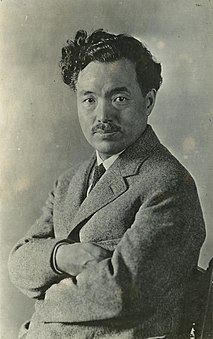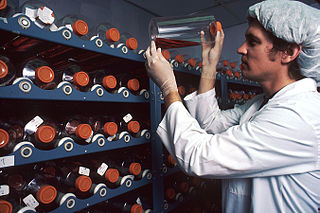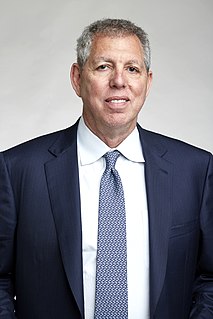
Ernest Orlando Lawrence was an American nuclear physicist and winner of the Nobel Prize in Physics in 1939 for his invention of the cyclotron. He is known for his work on uranium-isotope separation for the Manhattan Project, as well as for founding the Lawrence Berkeley National Laboratory and the Lawrence Livermore National Laboratory.

Albert Abrams was a fraudulent American physician, well known during his life for inventing machines, such as the "Oscilloclast" and the "Radioclast", which he falsely claimed could diagnose and cure almost any disease. These claims were challenged from the outset. Towards the end of his life, and again shortly after his death, many of his machines and conclusions were demonstrated to be intentionally deceptive or false.

Perpetual motion is the motion of bodies that continues forever in an unperturbed system. A perpetual motion machine is a hypothetical machine that can do work infinitely without an external energy source. This kind of machine is impossible, as it would violate either the first or second law of thermodynamics or both.

Orgone is a pseudoscientific concept variously described as an esoteric energy or hypothetical universal life force. Originally proposed in the 1930s by Wilhelm Reich, and developed by Reich's student Charles Kelley after Reich's death in 1957, orgone was conceived as the anti-entropic principle of the universe, a creative substratum in all of nature comparable to Mesmer's animal magnetism (1779), to the Odic force (1845) of Carl Reichenbach and to Henri Bergson's élan vital (1907). Orgone was seen as a massless, omnipresent substance, similar to luminiferous aether, but more closely associated with living energy than with inert matter. It could allegedly coalesce to create organization on all scales, from the smallest microscopic units—called "bions" in orgone theory—to macroscopic structures like organisms, clouds, or even galaxies.

The history of perpetual motion machines dates at least back to the Middle Ages. For millennia, it was not clear whether perpetual motion devices were possible or not, but modern theories of thermodynamics have shown that they are impossible. Despite this, many attempts have been made to construct such machines, continuing into modern times. Modern designers and proponents sometimes use other terms, such as "overunity", to describe their inventions.

Voodoo Science: The Road from Foolishness to Fraud is a book published in 2000 by physics professor Robert L. Park, critical of research that falls short of adhering to the scientific method. Other people have used the term "voodoo science", but amongst academics it is most closely associated with Park. Park offers no explanation as to why he appropriated the word voodoo to describe the four categories detailed below. The book is critical of, among other things, homeopathy, cold fusion and the International Space Station.

Hideyo Noguchi, also known as Seisaku Noguchi, was a prominent Japanese bacteriologist who in 1911 discovered the agent of syphilis as the cause of progressive paralytic disease.
Raymond Vahan Damadian was an American physician, medical practitioner, and inventor of an NMR scanning machine.
"The Billiard Ball" is a science fiction short story by American author Isaac Asimov, written in September 1966 and first published in the March 1967 issue of If. It appeared in Asimov's 1968 collection Asimov's Mysteries, in his 1973 collection The Best of Isaac Asimov, in his 1986 collection Robot Dreams and in The Complete Stories, Vol. 2.

An electrostatic generator, or electrostatic machine, is an electrical generator that produces static electricity, or electricity at high voltage and low continuous current. The knowledge of static electricity dates back to the earliest civilizations, but for millennia it remained merely an interesting and mystifying phenomenon, without a theory to explain its behavior and often confused with magnetism. By the end of the 17th century, researchers had developed practical means of generating electricity by friction, but the development of electrostatic machines did not begin in earnest until the 18th century, when they became fundamental instruments in the studies about the new science of electricity.
Nikolai Alexandrovich Kozyrev was a Soviet Russian astronomer and astrophysicist.

Medical research, also known as experimental medicine, encompasses a wide array of research, extending from "basic research", – involving fundamental scientific principles that may apply to a preclinical understanding – to clinical research, which involves studies of people who may be subjects in clinical trials. Within this spectrum is applied research, or translational research, conducted to expand knowledge in the field of medicine.
Energy medicine is a branch of alternative medicine based on a pseudo-scientific belief that healers can channel "healing energy" into a patient and effect positive results. Practitioners use a number of names including various synonyms for medicine and sometimes use the word vibrational instead of or in concert with energy. In most cases there is no empirically measurable energy involved: the term refers instead to so-called subtle energy. Practitioners may classify practice as hands-on, hands-off, and distant where the patient and healer are in different locations. Many schools of energy healing exist using many names: for example, biofield energy healing, spiritual healing, contact healing, distant healing, therapeutic touch, Reiki or Qigong.

Jeffrey M. Friedman is a molecular geneticist at New York City's Rockefeller University and an Investigator of the Howard Hughes Medical Institute. His discovery of the hormone leptin and its role in regulating body weight has had a major role in the area of human obesity. Friedman is a physician scientist studying the genetic mechanisms that regulate body weight. His research on various aspects of obesity received national attention in late 1994, when it was announced that he and his colleagues had isolated the mouse ob gene and its human homologue. They subsequently found that injections of the encoded protein, leptin, decreases body weight of mice by reducing food intake and increasing energy expenditure. Current research is aimed at understanding the genetic basis of obesity in human and the mechanisms by which leptin transmits its weight-reducing signal.

The Discovery Institute has conducted a series of related public relations campaigns which seek to promote intelligent design while attempting to discredit evolutionary biology, which the Institute terms "Darwinism." The Discovery Institute promotes the pseudoscientific intelligent design movement and is represented by Creative Response Concepts, a public relations firm.

Radionics—also called electromagnetic therapy (EMT) and the Abrams Method—is a form of alternative medicine that claims that disease can be diagnosed and treated by applying electromagnetic radiation (EMR), such as radio waves, to the body from an electrically powered device. It is similar to magnet therapy, which also applies EMR to the body but uses a magnet that generates a static electromagnetic field.

Kevin J. Tracey, a neurosurgeon and inventor, is the president and CEO of the Feinstein Institute for Medical Research, professor of neurosurgery and molecular medicine at Donald and Barbara Zucker School of Medicine at Hofstra/Northwell, and president of the Elmezzi Graduate School of Molecular Medicine in Manhasset, New York. The Public Library of Science Magazine, PLOS Biology, recognized Tracey in 2019 as one of the most cited researchers in the world.
Andrew A. Skolnick is an American science and medical journalist and photographer best known for his investigative reporting on health care issues, alternative medicine, and paranormal claims.
Logology is the study of all things related to science and its practitioners—philosophical, biological, psychological, societal, historical, political, institutional, financial. The term "logology" is back-formed from the suffix "-logy", as in "geology", "anthropology", etc., in the sense of the "study of science". The word "logology" provides grammatical variants not available with the earlier terms "science of science" and "sociology of science", such as "logologist", "logologize", "logological", and "logologically". The emerging field of metascience is a subfield of logology.

Havana syndrome is an alleged set of medical symptoms with unknown causes experienced mostly abroad by U.S. government officials and military personnel. The symptoms range in severity from pain and ringing in the ears to cognitive difficulties and were first reported in 2016 by U.S. and Canadian embassy staff in Havana, Cuba. Beginning in 2017, more people, including U.S. intelligence and military personnel and their families, reported having these symptoms in other places, such as China, New Delhi, India, Europe, and Washington, D.C. The cause and validity of the illness have yet to be determined.












